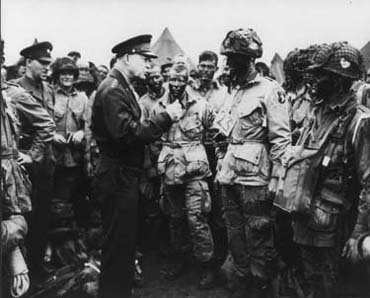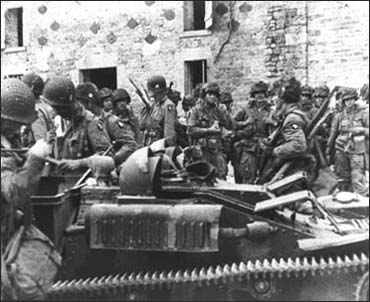|
|
 |
|
Debarkation Day as President
Eisenhower called it.
On 5 June 1944, the thousands of ships and craft taking part in Operation NEPTUNE put to sea and began gathering in assembly
areas southeast of the Isle of Wight. From there, many passed through the channels swept through the German defensive minefields
and moved into their respective waiting areas before dawn on 6 June. Hundreds of antisubmarine escorts and patrol planes protected
the flanks of these assault convoys. Between 0530 and 0550, the Allied gunfire support task groups began bombarding prearranged
targets along the beaches.
In the American sector, the landing at Utah beach began at 0630 and--despite occurring slightly
south of the target area--proceeded according to plan as the U.S. 4th division advanced rapidly toward its initial objectives.
At Omaha beach, where the landings began at 0635, underwater obstacles bottled up many of the amphibious craft and the congestion
provided easy targets for German gunners. The landing bogged down and it took a combination of short-range destroyer gunnery
support, aerial bombardment and desperate infantry assaults to break the German defenses. It was not until noon that the U.S.
1st and 29th divisions crossed the beach line in force.
The British sector proceeded more smoothly. Despite rougher
seas and higher-than-expected tides, which hindered the clearance of beach obstacles, excellent naval gunfire support kept
German defensive fire suppressed at Sword and Juno beaches. The landings there, which began at 0730 and 0735 respectively,
proceeded apace and the British 3d and Canadian 3d divisions moved inland by early afternoon. At Gold beach, where the 50th
division landed at 0725, the beach obstacles were more numerous than expected and many landing craft were lost. This hindered
the buildup of forces ashore and it wasn't until nightfall that the beach was secured.
|
 |
|

The Airbourne Assault into Normandy as part of the D-Day Allied invasion of Europe was the largest use of airborne troops
up to that time. Paratroopers of the U.S. 82nd and 101st Airborne divisions, the British 6th Airborne Division, the 1st Canadian
Parachute Battalion, and other attached Allied units took part in the assault. Numbering more than 13,000 men, the paratroopers
were flown from bases in southern England to the Cotentin Peninsula in approximately 925 C-47 airplanes. An additional 4,000
men, consisting of glider infantry with supporting weapons and medical and signal units, were to arrive in 500 gliders later
on D-Day to reinforce the paratroopers. The parachute troops were assigned what was probably the most difficult task of the
initial operation -- a night jump behind enemy lines five hours before the coastal landings.
To protect the invasion zone's western extremity and to facilitate the "Utah" landing force's movement into the Cotentin
Peninsula, the U.S. 82nd and 101st Airborne divisions descended on the peninsula by parachute and glider in the early hours
of D-Day. The paratroopers were badly scattered. Many were injured and killed during the attack, and much of their equipment
was lost. But the brave paratroopers fought fiercely, causing confusion among the German commanders and keeping the Germans
troops occupied. Their efforts, hampered by harsh weather, darkness and disorganization, and initiative of resourceful soldiers
and leaders, ensured that the UTAH BEACH assault objectives were eventually accomplished. The British and Canadian attacks
also accomplished their primary goal of securing the left flank of the invasion force

|
| Marines in a landing ship prepared to fight |

|
| The last moments before the plunder |

|
| Tactical marines about to kick some German butt |

|
| Victory on the beach is complete |

|
| Soldiers that have pushed past the beaches and into the French village of St. Marcouf |
US First Army
- XII Corps
- XV Corps
US Third Army
- V Corps
- VII Corps
- VIII Corps
- XIX Corps
Armored Divisions
- 2nd Armored Division (2 July)
- 3rd Armored Division (9 July)
- 4th Armored Division (28th july)
- 5th Armored Division (2 August)
- 6th Armored Division (28th July)
- 7th Armored Division (14 August)
- 2nd French Armored Division (1 August)
Airborne Divisions
- 82nd Airborne Division (6 June)
- 101st Airborne Division (6 June)
Infantry Divisions
- 1st Infantry Div (6 June)
- 2nd Infantry Div (8 June)
- 4th Infantry Div (6 June)
- 5th Infantry Div (16 July)
- 8th Infantry Div (8 July)
- 9th Infantry Div (14 June)
- 28th Infantry Div (27 July)
- 29th Infantry Div(7 June)
- 30th Infantry Div (15 June)
- 35th Infantry Div (11 July)
- 79th Infantry Div (19 June)
- 80th Infantry Div 8 Aug)
- 83 rd Infantry Div (27 June)
- 90th Infantry Div (10 June)
Allied Expeditionary Air Forces consisted of the:
US Airforce
- US Ninth Tatical Airforce
- US Eighth Airforce
Royal Air Force
- Second Tatical Force
The British 21st Army Group
consisted of:
The British Second Army
Armored Divisons
- Guards Armored Div (28 June)
- 7th Guards Armored Div (8 June)
- 11th Armored Div (13 June)
- 79th Armored Div (Specialized Armor 6 June)
Airborne Divisions
6th Airborne Div (6 June)
Infantry Divisions
- 3rd Infantry Div (6 June)
- 15th Infantry Div (Scottish 14 June)
- 43rd Infantry Div (Wessex 24 June)
- 49th Infantry Div (West Riding 6 June)
- 50th Infantry Div (Northumbrian 6 June)
- 51st Infantry Div (Highland 6 June)
- 53rd Infantry Div (Welsh 27 June)
- 59th Infantry Div (Staffordshire 27 June)
Canadian and Polish Forces attached to the British Army:
- 4th Canadian Armored Div
- 1st Polish Armored Div
- 2nd Canadian Div
- 3rd Canadian Infantry Div
|
 |
|
|
 |
|
|
 |
|
|
|
|
|
|
 |

